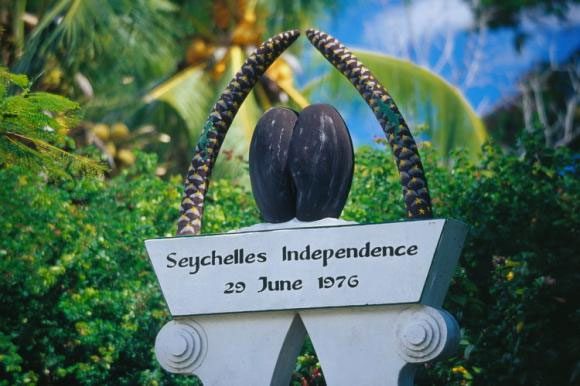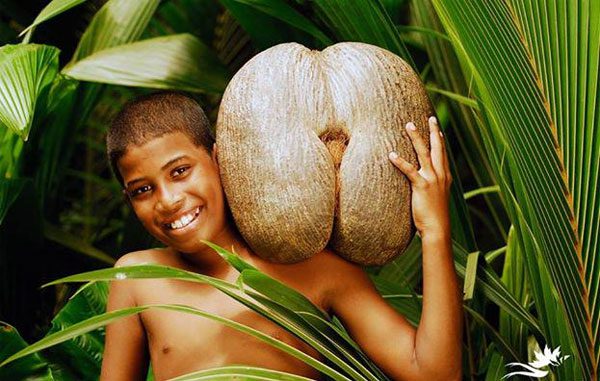A groundbreaking discovery on how to create the world’s largest seeds of the Coco de Mer coconut, “the treasure of Seychelles,” has been made by a group of German researchers inspired by a folk legend from the dreamy island nation of Seychelles.
The Coco de Mer coconut only grows in Vallée de Mai on Praslin Island (located in the southwestern Indian Ocean). On average, a single coconut weighs about 23 to 30 kg, measures 25 to 34 cm in height, and is approximately 7 to 10 cm long.
The Seychelles, home to the Coco de Mer, is often referred to as the pearl of the Indian Ocean. Situated off the eastern coast of Africa, it has piqued the curiosity of people around the world, particularly as the honeymoon destination of British Prince William and Kate Middleton.

Seychelles – The Pearl of the Indian Ocean
The seeds of the Coco de Mer coconut are the largest and heaviest in the world, believed to have developed from trees that once grew under the Indian Ocean. Even after this coconut species began to grow on land, local people still believe that for this seed to form, the male and female trees must embrace each other during a stormy night.
How does a tree thriving in such a barren landscape produce a seed that can measure up to half a meter in diameter and weigh around 25 kg?

New Discoveries by Scientists Focused on Creating the World’s Largest Seed
The recent invention by scientists delves into how to produce the world’s largest seeds of the Coco de Mer, a treasure of the Republic of Seychelles, colloquially referred to as “the fruit of the phallus” due to its peculiar and unique shape.
A team of researchers from the Technical University of Darmstadt in Germany analyzed the leaves, trunks, flowers, and seed samples taken from the Coco de Mer trees on Praslin Island. They discovered that the Coco de Mer leaves contain only about one-third the nitrogen and phosphorus concentrations typically found in the leaves of other trees and shrubs in Seychelles. Furthermore, before the leaves mature and fall, the palm trees extract most of the nutrients from the leaves and recycle them to grow this largest fruit in the world. Thus, the nutrients from the tree are less concentrated in the leaves and more focused on the palm itself to nourish the developing coconut.
However, this is not the only way nutrients are supplied to the fruit. The large and layered leaves effectively channel rainwater down the trunk. Researchers also found that this water carries various nutrients from dead leaves, flowers, pollen, and bird droppings, washing them down to the soil around the tree’s base. Consequently, nitrogen and phosphorus concentrations in the soil located 20 cm from the tree trunk are at least 50% higher than in soil 2 meters away.
This discovery connects with a notable event regarding this palm species: it appears that the Coco de Mer is the only palm in the plant kingdom that cares for its seedlings after germination. The researchers also found that seedlings benefit from growing in the shade of their parent trees, as they can access more nutrient-rich soil there.

This New Discovery Also Proposes a Hypothesis on Why the Seeds of This Coconut Are So Large.
However, this still does not explain why the seeds of this tree are so large. According to one hypothesis, researchers may need to look back to the time of the dinosaurs. About 66 million years ago, the ancestral forms of this palm may have relied on animals to disperse their relatively large seeds – but this mechanism was lost when pieces of the continental crust that included Seychelles separated and formed the Indian Ocean, simultaneously isolating this palm species.
This means that seedlings had to adapt to grow in the shade of their parent trees. Because large seeds contain a good supply of nutrients, the seedlings are provided with this abundant resource, ultimately allowing them to outcompete most other tree species in the ecosystem. To this day, the Coco de Mer remains the dominant tree in their growing forests.
When a forest is dominated by a single species, competition shifts from interspecies rivalry to competition among siblings of the same species. This means that the Coco de Mer palms gradually develop larger seeds by providing their offspring with a rich reservoir of nutrients to enhance their chances of survival compared to their siblings.
However, the Coco de Mer palm still holds many mysteries, such as how its flowers, the largest in the world, are pollinated. The folk legend about the male tree uprooting itself to embrace the female tree during a stormy night to produce seeds adds an intriguing layer to this mystery.





















































